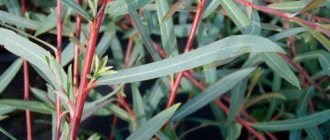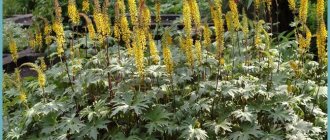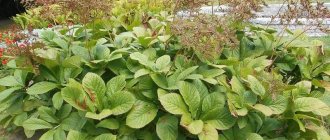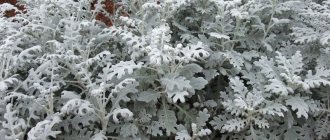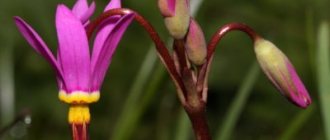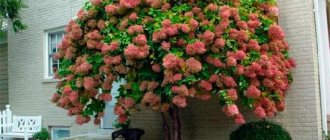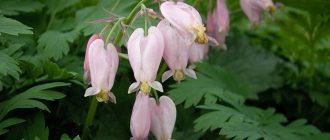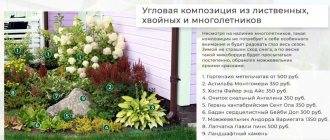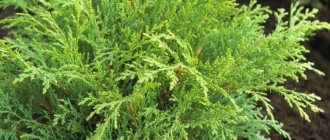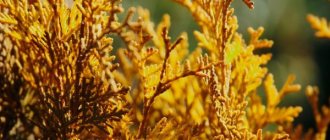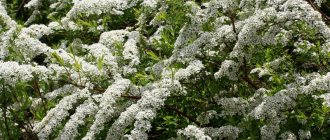Description of the flower
Grows mainly in damp areas. Its habitat is Europe and Asia; the plant can also be found in South Africa, America, New Zealand and Australia. In this section you will learn what a forget-me-not flower looks like.
Forget-me-not is an annual or perennial plant (it depends on the variety). The stems are branched, similar to a small shrub, reaching a height of 40 cm. However, there are species with taller creeping flowers. Depending on the type of flower, the leaves can be linear-lanceolate, sessile, lanceolate, or spatulate. Foliage color can vary from bright green to grayish green. The inflorescence is collected from several blue flowers with a yellow center. Also, the color of the flower can be pink or white.
The flowering period begins in May and lasts until mid-June; after flowering ends, the fruit appears - a nut. One gram can contain up to 2000 seeds, which can be stored without damage to germination for up to 3 years. The seeds are black in color and ovoid in shape. The first shoots appear a few weeks after sowing.
Description
The forget-me-not plant is quite common throughout the world and especially in a number of European countries, where it is often used as a garden decoration.
For example, in England there is a spring holiday in honor of the May Queen flower. According to French beliefs, the forget-me-not flower is a symbol of pure love.
In Russia, this flower is associated with youth, lightness and tenderness. There is a belief: a forget-me-not placed on a lover’s heart will make his love strong and eternal.
There are about 40 species of forget-me-nots growing in our country. One of the most common sisters of the forest forget-me-not is the Krylova forget-me-not. This beautiful plant grows in the regions of Siberia and Central Asia.
General information
Another type of flower is the pleasant forget-me-not. It has a long and spreading root system.
The Alpine forget-me-not variety is well known. The flower received this name from the area where it grows - the Alps. This is a perennial variety with a small root system, low stems up to 15 centimeters and blue flowers.
Flowering time begins in May and lasts up to 50 days. This variety loves sunny areas and is therefore often found on rocky surfaces. It is this type of forget-me-not that has become the main one for breeding decorative varieties.
Forget-me-not is located along the edges of various types of reservoirs and in shady areas. The main geolocation of the variety is Western Transcaucasia, the Balkans and Mongolia. It is a perennial shrub. The species has tall stems of 40 centimeters, wide leaves and large light blue fruits. Forget-me-not is the parent of such varieties as Thuringian. This individual is distinguished by the dark blue color of its fruits.
Alpine garden forget-me-not is a biennial plant that is very easy and responsive to care for. For active growth, both sunny and shady areas are suitable for it. The height of the alpine decorative forget-me-not reaches up to 30 centimeters, the flowers have a delicate blue tint. There are also varieties with pink and blue flowers.
It begins to bloom by mid-May, the period is approximately 40 days. Easily adapts to droughts and tolerates light frosts. The seeds fall off by the beginning of July and a month later new bushes begin to grow.
Forest forget-me-not is located mainly in the regions of central Europe. This species prefers humidity and shade. Characterized by its density and height, reaching up to 40 centimeters. Forest forget-me-not flowers are medium in size, reaching up to one centimeter in diameter.
Their soft blue color creates a clearing of heavenly shades. The flowering period is standard for forget-me-nots - about 45 days. Looks good in design solutions together with tulips.
Description of the plant and species
The description of the flower is difficult to fully describe, since it includes many varieties. One of the species of this variety is the marsh forget-me-not. It is unique for its 30 cm stem with four edges. Due to the pubescence, it appears gray in color and further corresponds to its Greek name. After all, the appearance is very reminiscent of mouse ears. People gave it the name gourd, fever herb, and honeypot. The diameter of the flower is like a ruble coin. Their inflorescence is shaped like a curl.
Forget-me-not
Branches are directed from each axis, located only on one side. The flower is flat. It consists of five petals painted blue. They have yellow scales that cover the throat. It is shaped like a wheel.
There are approximately 61 known types of flowers and the most common are the following:
- Alpine forget-me-not is drought-resistant, prefers stones and crevices between them in places that are well lit by sunlight.
- Swampy - located on swampy banks, near a pond or ditch.
- Forest forget-me-not - the name gives away its natural habitat. These are the edges of mixed forests.
- Forget-me-not is a rather unusual native area. These are Karelia and the Scandinavian countries, the Alps and the Pyrenees.
Note! Flowering usually occurs in May-June, and fruiting occurs in the month of August.
Forget-me-not flower - description
The plant has a relatively short height, although it all depends on the variety. The forget-me-not flower has about 50 different species, all of them belong to the Borachnikov family. Most varieties are cultivars and hybrids. The name of the flower is composed of two Greek words mouse and ear. People also call it gourd, fever herb, and gourd. The description of forget-me-not indicates that the flowers are very durable when cut. With frequent changes of water, they can last in a vase for almost a month.
What does a forget-me-not flower look like?
The plant can be planted on the site and in a pot. The forget-me-not flower in a flowerbed can be grown as a one-, two-, or perennial plant. This is a herbaceous crop that grows mainly in moist, slightly shaded areas. To understand what a forget-me-not looks like, you need to go through the main characteristics:
- The stems
reach a height of 40 cm and are strongly branched, creating a real hat. - Leaves
are sessile, lanceolate, linear or scapular. - Inflorescences
are racemose. - The color of the buds
is varied. - The smell of the forget-me-not flower
is light, barely perceptible. - The fruit
is a nut with many seeds.
What colors do forget-me-nots come in?
The traditional color of the flowers is pale blue. However, thanks to the work of breeders, other options can be found. Forget-me-not color can be:
- blue;
- blue;
- pink;
- purple;
- creamy;
- white.
Where does the forget-me-not flower grow?
The plant can be found almost all over the world. Those who are little familiar with it are interested in where forget-me-not grows. Currently, flowers can be found in Europe, New Zealand, Africa, America, the Caucasus, Siberia and Australia. They grow in shady or semi-shady areas near swamps, rivers, lakes, roadsides or forest clearings. This should be taken into account when choosing a place to plant this flower crop.
Description: varieties and varieties of garden forget-me-nots
Forget-me-not is a pleasing herbaceous plant. The vast majority of its varieties and varieties bloom at the end of spring and the first days of summer. A flower cultivated for the garden, which is also called sapling, mouse ear, or gourd, is usually a perennial. But its cultivation is advisable only in a two-year format. Subsequently, the plant grows greatly and loses its decorative effect: the stems become elongated, the inflorescences become very thin.
Breeders have developed about a hundred varieties and hybrids of forget-me-nots. Gardeners in the Russian Federation often plant those obtained from field and marsh varieties. Recently, the alpine or garden forget-me-not has become increasingly popular. Previously, it could be seen in pots on the windowsill, and now in open ground. The homeland of this variety is the Alps, Carpathians and the Caucasus.
Characteristics and distinctive features of the Alpine forget-me-not:
- The stem is short, 5-15 cm. The branching is strong.
- The leaves are medium-sized, rounded with a pointed end. Color: grey-green.
- The roots are short and shallow.
- The flowers are small and densely dotted on the shoots. Garden forget-me-not blooms for about 7 weeks, starting in May.
- After flowering (in July), small smooth boxes with a large number of seeds form on the shoots. If you collect them and sow them, by August the plant will sprout new shoots.
The native color of the garden forget-me-not is deep blue. Currently, many varieties have been bred that differ in petal color, flowering period and stem height. Most in demand:
- Carmine King, Rosylva, Victoria Rose - petals of different shades of pink;
- Compinidi, Miro, Blue Bird, Indigo Compacta, Victoria, Music - shades of blue;
- Blauer Korb, Indigo, Amethyst, and Blue Ball have deep blue petals.
Advice. There are also varieties with purple, white, and cream petals. A lot of them. Base your choice on descriptions of characteristics and photos of plants. Flowers are no different in terms of growing technology and care.
Legends and myths
There are a large number of myths and legends why the flower received such a name.
According to one legend, a beautiful forget-me-not flower appeared in the place where the bride, who parted with her beloved, was crying.
Another legend tells about the unusual name of the flower. The goddess of flowers and all living things - Flora gave names to all the seedlings, but forgot about the small blue miracle. But the flower asked for a name, and so that she would never forget about him again. This is how the flower appeared - the forget-me-not.
There is a Greek myth according to which there lived a young guy named Lykas. He was a shepherd. When the young man said goodbye to his love, he gave her a bouquet of blue flowers - forget-me-nots.
In different countries, the flower received different names. If in England forget-me-not is forget-me-not, then in France it is ne-moubliez-pas, and in Portugal it is nao-me-esquecas. Regardless of the name, the translation is the same and means – Don’t forget me.
Forget-me-not flowers - growing
The plant loves shady places, but with constant soil moisture it will grow well even in sunny areas. The main thing is that there is a sufficient amount of nutrients in the soil. Planting and caring for forget-me-not flowers is no different from other plants. They also need watering, fertilizing and loosening the soil.
How to plant forget-me-nots?
For full flowering, you need to first grow seedlings. Forget-me-nots are planted in open ground when the seedlings are strong and it is warm. Sowing seeds includes the following steps:
- Take a container with drainage holes.
- Prepare a substrate from turf soil and sand (2:1).
- The seeds are immersed in it and sprinkled with a little earth.
- A greenhouse is created on top until the shoots appear, and then it is removed.
- The formation of the first true leaves is time for picking into separate containers.
How to care for forget-me-nots?
The flower is unpretentious in care, so you need to do a minimum amount of work and the plant will delight you with its beauty for a long time. Forget-me-not care includes the following steps:
- Location
. It is better to choose shade or partial shade. Otherwise, you will need to increase the amount of moisture. - watering
is required. It is important to monitor the condition of the leaves; they should be elastic and fresh. - Lighting
. Although forget-me-nots grow well in the shade, they cannot fully develop without light. It is ideal if during the day the plant is exposed to the sun for about 6 hours. This will create conditions for abundant flowering. - Fertilizer
. Young forget-me-not flowers are fed with liquid mineral fertilizers two weeks after planting. Suitable ammonium nitrate, superphosphate, potassium chloride, the ratio is: 2:3:1. Organic matter is added to adult plants every autumn. Forget-me-not also likes watering with mullein, which is diluted with water 1:10. - The soil needs to be loosened and weeds removed
for a constant supply of nutrients. - Trimming
. After the buds have faded, it is recommended to remove them. This will allow new flowers to appear.
What does a forget-me-not flower look like?
Forget-me-nots are delicate and unpretentious flowers; they belong to the Borachnikov family. Often these are low or medium-sized plants with a height of 5 to 35-40 cm. They decorate gardens and flower beds and are used instead of a regular lawn.
Delicate and unpretentious flower
Forget-me-not is popular among gardeners due to:
- variety of bud colors. You can plant blue, pink, white and lilac flowers nearby - you will get a wonderful multi-colored carpet;
- branched stems, which give the impression that every centimeter of the garden is covered with flowers.
The leaves are green and may have a lanceolate, linear or spatulate shape. The inflorescences have a racemose shape. In place of the faded bud, a box with seeds is formed. There are many of them and they are very small.
Important! 1 kg of fruit bolls contains at least 2 thousand black, ovoid workers, ready for planting seeds
Multi-colored buds on one plant
Why is forget-me-not called so?
It is interesting that residents of many countries around the world, when they see a flower, pronounce the same word in meaning, which fully corresponds to its description. From Latin its name can be translated as mouse ear. The plant is also called gourd grass, fever grass or sapling grass.
According to legend, Flora, who walked the earth and gave names to everyone, did not notice the small plant. It was very afraid that it would remain without a name, so it spoke. The goddess heard the flower calling her, repeating: Don't forget me. She was surprised and decided to call him Forget-Me-Not.
When forget-me-nots bloom
Blooms in late May-early June. Flowering is long, lasting on average up to 40 days, while the flowerbed is never left without flowers, new buds quickly replace the faded ones.
Forget-me-not has a long flowering period
How to use forget-me-nots in landscape design
Forget-me-nots are usually used to decorate flower beds, balconies and flower beds. But before choosing a place, you need to learn more about the characteristics of the variety. The swamp species feels better near a self-made pond.
Since the stem is short and the flowers are small, they are not allowed to form living borders. They look good in flower beds, pots, and rockeries.
This flower is not afraid of the cold. It can be safely grown together with tulips and near daffodils. Pairs well with ferns and lilies of the valley. When decorating bouquets, you can add daisies and pansies.
A close relative of the forget-me-not is considered to be the lungwort. They belong to the same family, although the appearance is completely different, only the color scheme is the same.
Collections
Army SongsPiano ClassicsMusic from AdvertisingChildren's Cartoon SongsMusic for AerobicsCollection of 70s SongsFor a Loved OneClassics in Modern ArrangementsClub Mixes of Russian Performers3D SoundTruckersForeign Rap for the CarTop Club TracksPowerful BassDisco 2000Songs about DadChristian SongsWinter MusicMusic for MeditationRussian Hits 90ХSad MusicRomantic SaxophoneDance hip-hopNew Year songsForeign hits 80 - 90Songs about PokemonRomantic MusicMotivation for trainingMusic for sexMusic for the carFor strength trainingGrammy 2017 Award
Types and varieties of forget-me-nots
About 35 of 61 species grow in Russia, not counting hybrid ones. Each of them finds application in landscape design. Knowing when forget-me-nots bloom, you can make magical clearings in the garden.
Forget-me-not swamp
It can be found on the shores of almost every body of water. The stems are green, branched, up to 30 cm high. The leaves are lanceolate, the flowers are small, no more than 1.5 cm in diameter, of a delicate blue color. A hybrid of the marsh forget-me-not is Semperflorens. The marsh forget-me-not differs from others in the presence of bright buds that are blue in color and have a yellow core.
Pond decoration
Forget-me-not field
A herbaceous plant that lives in one place for 1-2 years. It is grown to obtain raw materials from which medicines are subsequently prepared. The flower is quite tall, approximately 40-60 cm in height. The stem is straight, pubescent. Small pale blue flowers up to 2-3 mm in diameter are collected in loose racemes. Blooms in May and blooms until September.
Forget-me-not
Not cultivated. The appearance depends on the conditions in which the flower grows. The creeping forget-me-not, which grows in the swamp, has branched stems that stretch 40-45 cm in height. The flowers are light, sky blue, the core is yellow. It blooms in summer, most often in June.
Forest forget-me-not
Biennial or perennial. The color of the buds depends on the variety. There are pink, white and blue forest dwellers. The stem is pubescent, branches, stretches to a height of 30-40 cm. The flowers are small, up to 1 cm in diameter, the stem usually ends in a lush brush or curl of 5-6 buds.
Alpine forget-me-not
Prefers rocky soil and is the basis for breeding hybrid varieties. The stems of the plant are small, the plant is not tall - approximately 10-15 cm in height. The buds are blue, flowering lasts 25-40 days.
Prigozhnitsa is often used for alpine slides
Forget-me-not pink
This perennial prefers moist soil and partial shade. The buds are dark pink. Suitable for growing in regions where droughts in summer and frosts in winter become commonplace. It has significant endurance.
You can grow wild types of forget-me-nots in the garden
Any plant species, including those growing in the wild, can be grown in a flower bed. To do this, it is enough to transplant perennials from their usual soil into garden soil. This should be done in the fall. It is advisable to take more planting material. The risk of death of some plants is quite high. Annuals are propagated by seed.
You can’t take your eyes off such a flowerbed
When to plant forget-me-not seedlings: optimal timing
The timing of sowing seeds for seedlings largely depends on when you want to see flowering! If you want to enjoy blooming forget-me-nots at the end of April or at the beginning of May, then you should sow them already at the end of October, in November. And if you want to see flowering in July-August, then you should sow at the standard time, approximately in March.
However, when planting early in October-November, it is necessary to constantly (in the morning and evening, and sometimes even during the day) illuminate the seedlings with phytolamps, otherwise the seedlings simply will not be able to grow and develop normally, they will stretch out and weaken.
When planting in spring, it is optimal to plant forget-me-not seedlings during March. The 2021 Lunar calendar will help you choose a specific sowing day
- Favorable days: in January: 1, 2, 10, 11, 15, 16, 19, 20, 27, 29;
- in February: 17, 18, 22, 23, 24;
- in March: 1, 3, 4, 20, 21, 29, 30;
- in April: 9, 10, 15, 16, 17.
- Unfavorable days: in January: 12, 21, 22, 28;
- in February: 11, 27;
- in March: 12, 28;
- in April: 11, 26.
Growing and care
The plant is classified as both annual and perennial. Basically, they are grown for only 2 years. In the 3rd and 4th seasons, the flowers do not look so attractive, and their color fades significantly.
The soil
Soil is important for good flowering and growth. Moderately moist soil with sufficient fertilizer is best. But you should not choose very nutritious soil, because then the plant will grow actively, but will not bloom.
Watering
Although forget-me-nots love moisture, you should not water them too often. In the month of May, the plant practically does not need water, because there is already enough of it in the soil.
Fertilizers
Fertilizing should be done three times a season. The first is on the 14th day after planting. The plant is just starting to grow and needs additional care. Liquid mineral fertilizers are best suited. The second time it is worth applying organic fertilizers in September. In spring, the soil needs humus and peat.
In order for a sufficient amount of nutrients to reach the roots, the soil should be constantly loosened. The advantage of this plant is that weeding is not required for growth, since weeds cannot break through due to the well-developed root system.
Forget-me-nots need not be covered for the winter. They tolerate cold well.
Conditions for growing forget-me-nots
Grolyanka is unpretentious and does not require special conditions. A sufficient amount of light and shade, moderate watering, rare fertilizing, measures to protect against pests and diseases do not take much time and are accessible to beginning gardeners.
Watering
Irrigation is required 2 times a week for flowers growing in open sunny areas and alpine hills. Inhabitants of shady corners are watered once a week, provided there is no natural precipitation.
To reduce hassle, forget-me-nots are usually planted in the company of garden plants that reliably shade the soil.
Feeding
On overly fertile soil, the plant begins to fatten - to increase only the leaf mass. Therefore, fertilizers must be handled with extreme caution. During the season, it is enough to add peat or humus twice - in spring and autumn, and immediately after flowering, water with liquid mineral complexes.
Other care activities
Experienced gardeners recommend loosening the soil regularly, at least once every 10-15 days, so that nutrients and oxygen can easily reach the roots.
The flowers do not need weeding - the powerful root system drowns out the weeds trying to get out of the ground.
There is no need to prepare flowers for winter. The roots tolerate severe frosts well even without snow cover. Sometimes gardeners simply mulch their plantings with a thin layer of dry leaves.
Forget-me-not - care at home
Planting forget-me-nots.
A blue flower can please the eye for one year or several, depending on the plans of the owner of the garden. The flower can be planted by seeds, cuttings and dividing the bush. For future propagation of forget-me-not bushes, the easiest way is to sow seeds. Cuttings are used for varietal flowers. Then the tops are cut off in June and immediately planted. When propagated in this way, flowering is expected in the same season, but not too lush. Dividing a forget-me-not bush can be done in any season. It takes root well thanks to its strong roots.
Before planting a plant, you should choose the right place for future flowering.
The place should be sufficiently shaded. Although the plant is a light-loving plant, with plenty of light, the flowering period is perhaps a little shorter and the shade is not as saturated.
You can plant the flower directly with seeds in open ground. If forget-me-nots are planted with seeds, they expect flowering only next year. The soil is loosened in advance, fertilizers are added and then the seeds are planted in the furrows. Maintain an even distance, about the size of your palm will be enough.
The first shoots will appear in a couple of weeks, then they can be transplanted closer to each other.
Watering forget-me-nots should be moderate but constant, especially if the flower is planted in a shady area. Soil moisture should be maintained regularly, but watering can be reduced in May as the rains begin. If the forget-me-not is planted in a sunny area, water more often so that the leaves and stems do not dry out.
In early autumn, forget-me-nots are transplanted to a new location. Sometimes its seedlings are also prepared in the fall. This is done so that flowering begins earlier. In such conditions, watering is done carefully - through a napkin or sheet of paper. At the first shoots, the leaves are trimmed and can be transferred to the cold (you can directly into the greenhouse) until spring. You can transplant such seedlings into the ground in April, then flowering will occur by the end of the month.
Forget-me-not in the garden.
The flower began to be often used in the design of flower beds and flower beds. This delicate plant is found not only in the vastness of Russia; the French and Germans like to decorate their gardens with it.
Forget-me-nots are used to decorate artificial reservoirs, shading a pond or lake. This flower will also look good when planted separately, especially in pots or hanging flowerpots.
If you choose a company for a forget-me-not, daffodils and tulips will look advantageous and fresh nearby. In addition, all these flowers are frost-resistant, which means that the entire planting will stay together and will not lose its appearance. In shady compositions, fern and lily of the valley are planted next to forget-me-nots.
Forget-me-not: propagation, combination with other plants
Seeds are the most popular material for propagating forget-me-nots. Before planting, check them by dipping them in salted water. Floated samples are not ready for planting. The plant also grows effectively by self-seeding, so annual sowing in the flower bed is not necessary. The main thing is to have time to plant young plants.
Other options for propagating the crop:
- Cuttings. At the beginning of summer, cut 4-5 cm green cuttings from the tops. Root them in a greenhouse, then plant them in open ground. As a result, the plant will bloom in the first season, but weakly and for a short period.
- Plant division. Such propagation can be carried out at any time of the year. The root system of the plant is strong and quite developed.
Alpine forget-me-not is simply created for rockeries and ground cover compositions. Combination options can be seen in the photo. The combination of different shades of forget-me-nots looks beautiful. You can create entire carpet compositions from them. Forget-me-not brings a meadow spirit to the landscape. Use this property in decorating your site.
Reproduction methods
This flower is not a picky plant; even a novice gardener can grow forget-me-nots. It is better to choose a place in the shade, then flowering will last longer.
Using seeds
There are several ways that forget-me-nots can reproduce. The most famous and simplest of them is seeds. It’s easy to check their quality if you take a glass of water in which salt has been dissolved and put the seeds in it. If they float, they are not suitable for landing. All those that remain at the bottom are suitable seeds.
Before planting, loosen the soil in the prepared area and add peat. Make a hole in the ground and place the seeds at a distance of 10 cm from each other.
Shoots will begin to sprout in 10-12 days. At the first shoots, thinning should be done. If the distance between them is too small, then you can replant the plant.
You can plant seeds every year. The best time is autumn, then the first flowers will appear in the summer. Seeds are planted in a pot with light soil and drainage. When seedlings appear, they must be placed in a greenhouse with cold air until March. In spring, place the pot in a warm room. And already in April you can plant it in an open area.
Video about forget-me-not shoots:
Cuttings
By cuttings - the propagation method is suitable for some types of forget-me-nots. To do this, cut the top cuttings from the plant. Their size is usually 4-5 cm in length. It is best to get them in May or June. Plants that grow from cuttings will bloom the same year.
Division by bushes
The third method is division by bushes. The advantage of this method is that they can be divided in any season, and this will not affect its flowering in any way. This happens because the root system of forget-me-nots is powerful and easily adapts to new soil.
When the seeds fall off, new plants grow, which can be transplanted to other places if desired.
You should not allow abundant germination, because forget-me-nots can crowd out other flowers on the site.
Reproduction of forget-me-nots
All traditional methods are suitable for propagation: using seeds, cuttings, dividing the bush.
Seeds
Collected as they ripen. After drying, they are poured into a fabric bag and stored until sowing, but not more than 3 years. You can immediately sow fresh seeds in flower beds and flower beds. However, it should be remembered that hybrid forms of forget-me-nots do not transmit varietal characteristics if they are propagated in this way.
Sometimes summer residents don’t even bother collecting seeds - the plant grows well by self-sowing. In spring, young bushes are carefully dug up and planted in the right place.
Dividing the bush
The optimal way to increase the number of hybrid forms. The procedure can be carried out at any warm time of the year; the hardy root system tolerates division without damage and easily takes root in a new place.
The bushes are dug up and carefully divided into several parts. Each division is planted in a prepared hole.
Cuttings
Also used for propagation of hybrid and varietal highly decorative forget-me-nots. At the end of flowering, cut the apical shoots with a sharp, disinfected knife. Plant them immediately and cover them with polyethylene or transparent glass containers. Watering is carried out very carefully: water on the leaves is extremely harmful to cuttings. To make the bushes branch, they are pinched 1-2 cm.
With this method of propagation, blueberries bloom in the same year. But for the winter they need to be covered with spruce branches or agrofibre.
Popular types of forget-me-nots
There are about 50 species of forget-me-nots found in the wild. Flowers are common in South Africa, America, New Zealand and Australia. Many types of forget-me-nots are found in Russia. The most popular are field and marsh forget-me-nots.
Modest flowers are considered unpretentious plants. Forget-me-nots prefer damp places and grow best in fresh soil. Many species feel comfortable in the shade. Only alpine and field forget-me-nots love bright light. Forget-me-nots bred through crossing, as well as domesticated species, retain similar properties.
Forget-me-not swamp
In its natural environment it grows in the Transcaucasus, the Balkans, Siberia, Mongolia and Central Europe. Blooms throughout the summer. Preferring moist soil, it is found on the banks of ponds and swamps. Its characteristic features are branched stems, large leaves and flowers with pink or blue petals.
Alpine forget-me-not
Distributed in the Caucasus, Carpathians, and Alps. Prefers a lot of light. It has a meek rhizome and a low stem 5-15 cm high. Its distinctive feature is gray-green leaves and dark blue petals. It will bloom for about seven weeks.
Forget-me-not field
It is a medicinal plant. It has low shoots and small blue flowers. Its homeland is North Africa, Siberia, Asian countries, and the Canary Islands.
Forest forget-me-not
It is a perennial plant. It can be found in the Carpathians and European countries. Its height is about 30 cm. It has soft green oval, elongated leaves and light blue flowers.
Currently, breeders have managed to develop new hybrid species of flowers with multi-colored petals. There are flowers that have blue, blue, purple, cream, white and pink petals. Alpine forget-me-not is a rare guest in our gardens. Its domesticated counterpart is more common.
Forget-me-not field protection measures
Carrying out the necessary agrotechnical measures helps control the spread of this species and reduce the level of economic harmfulness.
Forget-me-not is sensitive to herbicides based on the active ingredient: dicamba; tribenuron-methyl 750 g/kg; Clopyralid, 267 g/l + picloram, 67 g/l; Iodosulfuron, 25 g/l + amidosulfuron, 100 g/l + mefenpyr-diethyl (antidote), 250 g/l; Fluroxypyr-meptyl, 250 g/l; desmedipham, 71 g/l + phenmedipham, 91 g/l + ethophumesate, 112 g/l.
Care, fertilizer and feeding of forget-me-nots. Diseases and pests
The basis of proper plant care is watering, fertilizing and thinning. In addition to waterlogging, which can lead to rotting of the roots, forget-me-nots do not tolerate drought well. Organize watering so as to prevent the top layer of soil from drying out, otherwise the plant will quickly bloom. Try not to get water on the greens.
To ensure abundant and bright flowering, regularly feed the garden bed. Use mineral fertilizer complexes for flowers. Apply the first small volume of solution 2 weeks after planting the plant in its permanent location. Later, in the fall, add organic matter and mineral fertilizers. Next spring, spread a mixture of compost and peat in a 3-5 cm layer in the flower garden.
Diseases and pests in open ground conditions torment the garden forget-me-not only if the technology of cultivation and reproduction is violated
Care and attention are important: do not allow the planting to thicken by regularly thinning the flower garden. Otherwise, powdery mildew, root or gray rot, and insect pests typical of flowers may settle on the plant.
For the latter, use insecticides, and to combat diseases, use drugs like Hom or Skor.
Don't let the soil dry out
Growing forget-me-nots from seeds
Planting any type is not much different, but different care may be required. There are more moisture-loving and less shade-tolerant representatives. For example, garden hybrids of alpine forget-me-nots thrive in the sun, but swamp forget-me-nots will fade faster in such conditions and lose their decorative properties.
Before you begin propagation, it is advisable to study the conditions for growing forget-me-nots. For planting, choose a slightly shaded area. The crop prefers light, fertile, well-drained soil without stagnant water.
The easiest way is to plant forget-me-not seeds directly in open ground. The best time is July. Pre-prepare the soil. They dig up the area, add humus and peat: no more than 5 kilograms per square meter, plus a little nitrophoska, about a tablespoon. Then you need to lightly dig up the ground again and level it.
Alpine forget-me-not
Tiny seeds are placed in shallow grooves, sprinkled with sand, and after careful compaction, a covering material is placed on top. After about 14 days, when shoots appear, the material is removed and the seedlings are thinned out.
They begin growing forget-me-not seedlings in April. The plant is quite persistent and almost all seedlings take root well. In July, the plantings will have already faded and ripened seeds will appear. They retain germination for up to 3 years, often germinate on their own and form persistent seedlings that can even overwinter.
Forget-me-not bushes can be safely divided, and at any age. It has a fibrous root system that adapts remarkably well to transplantation and does not experience rooting difficulties.
Varietal plants also reproduce well by cuttings. It is better to cut off the 4-5 centimeter long tops in June, during warm weather. They will quickly take root in the greenhouse.
Caring for forget-me-nots in the garden
When overwatered, the plant will stretch upward too intensely, then the roots will begin to rot. If you let it dry out, you won’t have time to stop admiring it – the forget-me-not will quickly fade. Regular but moderate watering should be provided. The jet is directed low, almost to the ground.
Forget-me-not garden blue
The plant needs systematic feeding. It is advisable to provide the easiest one 14 days after the forget-me-not is transplanted to a permanent place, always before the flowering period.
Solutions of mineral fertilizers from the store are suitable. In the fall, organic and mineral fertilizers are also applied, and in the spring a thin layer (3-5 centimeters) of a mixture of compost and peat is added.
In late autumn, forget-me-nots can be protected from frost and left in the same bed. If the winter is snowless, the plants may freeze, but usually they tolerate the cold well. Sometimes they are transplanted to a permanent place at the end of September, 3 pieces per hole. Then next year a thick flowering carpet will appear.
Forget-me-not in the garden
The most successful use of forget-me-nots in landscape design is group plantings with harmoniously selected shades of flowers. Swamp forget-me-not will decorate the lawn near the pond. Various hybrids of alpine forget-me-not will be a good choice for rockeries.
Forest forget-me-not will transform the border, and make a shady corner in the garden very natural and romantic. Low-growing varieties are often planted as ground cover.
In a bright flower garden, the plant goes well with daffodils, early-blooming daisies, tulips, delicate pansies and ferns.
The plantings will not look so attractive after the flowering period; they will begin to turn black and dry out. Then the bushes can be removed and replaced with other plants that bloom until late autumn.
Forget-me-nots are often grown in pots or baskets for landscaping balconies, verandas and terraces. Garden forget-me-not varieties are suitable for cutting and arranging picturesque summer bouquets.
How to grow forget-me-nots
When choosing soil for growing a plant, you need to consider two factors:
- the soil should not be too nutritious, otherwise the forget-me-not will grow greatly and practically not bloom;
- the soil should not be poor sandy, otherwise the flower will not grow well.
The ideal option is moist meadow soil. Next you will need to monitor the humidity level and follow the watering schedule.
Forget-me-nots need to be fertilized infrequently. After planting, 2 weeks later, you need to apply liquid mineral fertilizer. In the spring it is better to feed with peat and humus, and in the fall with organic mineral fertilizers.
During the period of plant growth, the soil must be loosened periodically to ensure better access to moisture and fertilizing. But forget-me-not does not need weeding - the powerful root system does not give weeds a chance to break out. The plants are not covered with anything for wintering.
For planting in the garden, choose a shaded place.
First you need to choose a place in the garden where the forget-me-not will receive enough light and be in partial shade. You can grow the plant next to tall flowers that will cast a shadow. For example, a spreading fern would be suitable as a neighbor.
In open ground, the best way to grow from seeds is:
- The soil is loosened well, peat and humus are added, then leveled.
- Furrows are made on the surface and the seeds are laid out in them, retreating approximately 10 cm between the holes.
- The seeds are lightly sprinkled with soil and covered with polyethylene on top.
- Water regularly, keeping the soil moist. This must be done carefully, spraying or passing water through a piece of cloth.
Forget-me-not shoots appear 2 weeks after planting. When the first leaves appear, it is necessary to thin out the sprouts or plant them at a distance of 5 cm from each other. Flowering begins in May and lasts up to 2 months.
Another option for planting forget-me-nots in the garden is to pre-grow seedlings. To do this, in the fall, plant seeds are sown in containers with light soil, slightly buried. Under the soil layer there must be a layer of expanded clay. It is better to water the seedlings before germination through a sheet of paper.
With the appearance of leaves, the seedlings dive and move to a cold greenhouse until the beginning of spring. At the end of April, seedlings can be planted in open ground. Flowering will begin in May.
Regardless of the growing method, planting and caring for forget-me-nots will not cause much trouble.
Reproduction
By properly planting and propagating forget-me-nots, you can create a beautiful carpet of flowers on your site.
There are three main ways to propagate forget-me-nots:
- Seeds. Seeds can be collected by hand during the period of fruit ripening. To do this, dried branches with fruits are cut off and the seeds are shaken out in the place where they want to grow forget-me-nots. But it’s easier to let the plant reproduce by self-sowing, after transplanting it to the right place. The main thing is to prevent the forget-me-not bushes from growing too much, periodically thinning them out.
- By dividing the bush. You can propagate forget-me-not flowers by dividing the bush into several parts. Transplantation can be done at any time of the year - the root system of the flower is very strong and can easily take root.
- By cuttings. The method is suitable for propagating varietal forget-me-nots. In early June, you need to cut off the green shoots at the top of the bush (about 5 cm). They are planted immediately in open ground, shaded and covered with film. Water carefully, trying not to get on the leaves. For better tillering, pinch the top a little. Plants propagated in this way bloom in the same season, but not for long. For the winter, the plant is covered with spruce branches or peat.
If you plant and propagate forget-me-not flowers correctly, you can get a beautiful multi-colored carpet that will decorate your garden.
How to plant forget-me-nots correctly
Growing forget-me-nots will not give you any particular difficulties.
When planting seeds
- It is better to plant the seeds directly in open ground.
- The best time for planting is July.
- The most important thing to do for the seeds before planting is to fertilize (add humus mixed with peat) and moisten the soil. The soil also needs to be loosened and dug up.
- Next, you should form small holes and place the seeds there, sprinkle with a small amount of sand (to form a thin layer of sand above the hole).
- It is advisable to cover the seeds with covering material. It will need to be removed in two weeks.
When planting cuttings and seedlings
- Prepare the soil - dig, loosen, fertilize and moisten.
- Plant it and the forget-me-not will take root.
Caring for forget-me-not garden
It is very easy to care for these unpretentious flowers; they only need careful watering at the root so that water does not get on the green parts of the plant, and loosening the soil layer. Do not overwater the plants, otherwise they will rot or become diseased. If the soil is constantly dry, then forget-me-nots, as a rule, fade very quickly. To ensure that plants reproduce by self-seeding, select several bushes and leave faded inflorescences on them so that the nuts and seeds begin to ripen. For other forget-me-nots, remove the inflorescences after flowering, otherwise they will fill the entire area. Forget-me-nots can be transplanted to other places both in the fall and during the period when they already have buds or flowers; these plants tolerate transplantation very well. In spring and autumn, you can feed forget-me-not bushes. To do this, add and stir a teaspoon of nitrophoska, potassium sulfate and urea into 10 liters of water. You can also take mineral complexes (Flower, Emerald, Agricola). Forget-me-nots can be damaged by cruciferous flea beetles, aphid colonies, slugs, and cutworms. Diseases that can affect plants: rot (root and gray), powdery mildew (true and downy). To prevent rot, forget-me-nots can be treated with Hom, and for powdery mildew - with Skor or Topaz. When aphids appear, it is necessary to spray with Iskra.
If the winters in your area are harsh, then mulch the forget-me-nots in the fall and cover them with spruce branches.
If you really love these modest blue flowers, then in the fall you can dig up one or more plants and transplant them into pots. They must be stored in the basement (the temperature there should not fall below zero). In February, move them into the room and place them on the windowsill. Then, already in March, forget-me-nots will delight you with abundant flowering.
Planting forget-me-nots in open ground
Rose Prairie Joy - characteristics and description of the bush
There is no particular difference between the plantings of the species; perhaps only different care will be required. Shade-loving forget-me-nots will be uncomfortable in direct sunlight and, conversely, varieties that thrive in the sun will bloom faster if they are out of place.
First you need to prepare the ground:
- Find a suitable place to land.
- Remove weeds.
- Fertilize unfavorable soil with mineral supplements in the fall.
